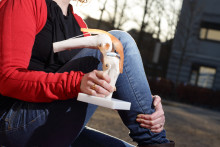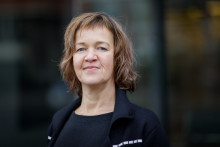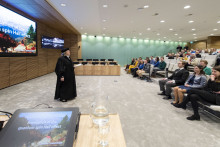‘Most people don’t know that cartilage does not have any cell repair capability. On top of that, most injuries remain unnoticed for about five years.’ According to Nicole Georgi, who defended her dissertation in March, the dangers of knee injuries are largely underestimated. ‘More than one million Dutch suffer from arthritic pain in their hips or knee, which might be the result of a preceding injury.’
When the damage is already done, the best thing to do is to repair the cartilage before whole new knees are required. In the current system, a patient can be operated upon to receive chondrocytes. Those are own cartilage cells, and are multiplied outside the patient’s body. Finally, a second operation is needed to insert the cells in the knee defect. But that is not all. Nicole: ‘By using the patient own stem cells have the ability to overcome this long treatment procedure. The difficulty, however, is to make sure the stem cells turn into cartilage, and the chondrocytes stay the same if they are multiplied outside patients body. This is tricky, and relatively large amounts of cells are needed.’
The new doctor believed that better methods should be available, and devoted herself to the optimization of cartilage tissue engineering. ‘I wanted to create the most perfect culture conditions for stem cells to multiply, and to make sure that they develop into what they need to be: cartilage. I discovered that oxygen plays a crucial role.’
One operation less
Nicole noticed that less oxygen limits aging and assists multiplication of stem cells external to the body. The implications are huge. ‘With this development, we can better combine stem cells and chondrocytes to generate tissue for cartilage repair. We need a smaller amount of chondrocytes, which makes the first operation no longer needed.’ Nicole clarifies. ‘This reduces time, costs, and of course trouble for the patient. Furthermore, the culture conditions create less risk that the tissue will evolve into bone instead of cartilage.’ There are already clinical trials at four hospitals that have started using this novel practice.
The German researcher is also aware of other developments to make life easier. In the future, it should be possible to 3D print organs. Nicole is sceptical about it, though. ‘It is certainly possible for small defects. As we speak. But I can hardly believe that it will be a realistic method to repair entire joints, including all different layers and their properties.’
Go away
Nicole finished her PhD in March. She is now working in the Molecular Nanofabrication group at the university. But not before she has given some advice to her younger peers. ‘I can strongly recommend to spent some time abroad, to look at your research from another angle.’ Nicole knows what she speaks about. She received personal funding to spend three months in Brisbane, Australia. ‘I did a small project there, but it resulted in a full chapter of my dissertation. At a certain time during a PhD, you get a certain stiffness and might get demotivated. Fresh points of view are inspiring.’







